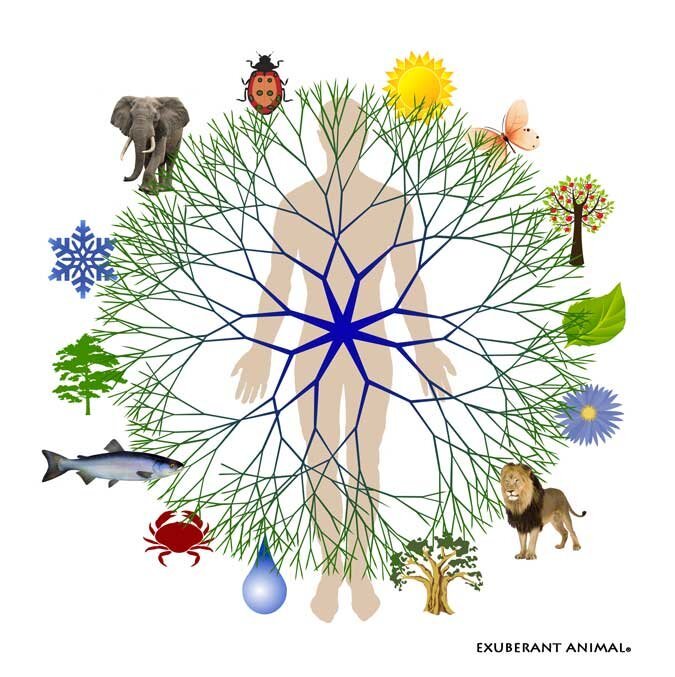The animal in question
Beyond my body my veins are invisible.
Antonio Porchia, Voces, 1943
This is an exciting time to be a Paleo enthusiast. We’re at the headwaters of a powerful cultural movement; our ideas are robust and our passions are intense. For most of us, our primary curiosity begins with the body. We wonder about our history as Homo sapiens and we look for ways to stay healthy in a difficult and often hostile modern world. But what is the nature of the body? Are we more than just the sum total of our anatomy and physiology? What can we really say about the fantastic and awesome entity that we inhabit? Here are some ideas to get us started…
the body is ancient
Conventional estimates put the age of the human species at 250,000 years, but if we include our human-like hominid ancestors, that figure is more like 6 million. But even this number is inadequate to describe our deep roots in biological history. Our primate lineage is 60 million years old and mammals go back at least 120 million years. Many of our most important physiological systems can be traced back hundreds of millions of years.
the body is embedded
Contrary to the isolated vision advanced by modern culture, the body is deeply continuous with habitat and the physiology of the natural world. We live in an external milieu that is absolutely essential for our survival. As Alan Watts put it, “it is as necessary to have air, water, plants, insects, birds, fish and mammals as it is to have brains, hearts, lungs and stomachs. The former are our external organs in the same way the latter are our internal organs.”
the body is complex
The details of anatomy and physiology are intricate beyond our imagination: billions of neurons, trillions of synapses, thousands of genes and hundreds of informational substances, all dancing and regulating one another in every moment of our lives. Even the inner workings of a single cell or membrane challenges our powers of comprehension. In fact, no one really understands how the body works.
the body is dynamic
Heraclitus was right; just as we can’t step into the same river twice, we can’t experience the same body twice. Not only does our physiology change constantly, our bodies are nested inside a dynamic social environment which in turn is nested inside a dynamic habitat. And of course, the body is incredibly plastic; gene expression and nervous system structure change with training and experience. We literally become what we do.
the body is rhythmic
Not only is the body constantly changing, its structure and function waxes and wanes in continuous oscillation. Our bodies follow the beat of habitat: sunlight, seasons and climate. Our pulse, our breath, hormone levels, appetite, energy and rest and are just the beginning. Even our cognition and spirit follows a rhythmic cycle of rise and fall.
the body is social
We are hyper-social primates; our bodies are massively interconnected and permeable to social influence. Our brains are social organs that work best in conversation with others; we crave attachment. Our experience with others is mediated by a powerful “resonance system” that responds to the non-verbal presence and behavior of others. Ultimately, our social nature is profoundly physical.
the body is individual
No two are exactly alike. Even small differences in genetic heritage, pre-natal environment, personal history, training, biochemistry, diet, and disposition can add up to huge differences in the way we respond to training and the world around us. It is folly to assume that any one diet, training program or medical procedure will work for everyone.
the body is subtle
Far more than a biochemical and biomechanical machine, the body responds, not just to the mechanical forces of physical training and environment, but also to the meanings that live in our stories and narratives. Placebo and nocebos are everywhere; our interpretation of the world actually shapes our tissue. To an astonishing degree, the stories that we tell about our lives determine our state of health.
the body is robust
When pressured by the urgency of survival, the body is capable of withstanding astonishing levels of injury, stress and disease. Adventure stories from every age demonstrate our ability to survive famine, dehydration, long winters, disease, isolation, trauma and predation. The body is far more resilient than we realize; it constantly heals itself and can tap into deep reserves of psycho-physical energy, especially when powered by a sense of meaning and purpose.
the body is temporary
And finally, there’s one remaining quality most of us would prefer to ignore. That is, our bodies survive for only a brief flicker of time. Once we pass the peak of youthful vitality, the body’s systems break down a little bit more with each passing day. No amount of training, dieting or meditation will change this basic fact. The Buddha had it right: it’s all impermanent. Get used to it.
organic-neuro-branching-2
